+ データを開く
データを開く
- 基本情報
基本情報
| 登録情報 | データベース: PDB / ID: 6vvo | ||||||||||||
|---|---|---|---|---|---|---|---|---|---|---|---|---|---|
| タイトル | Structure of the human clamp loader (Replication Factor C, RFC) bound to the sliding clamp (Proliferating Cell Nuclear Antigen, PCNA) | ||||||||||||
 要素 要素 |
| ||||||||||||
 キーワード キーワード | DNA BINDING PROTEIN / REPLICATION / sliding clamp / DNA replication / AAA+ / ATPase / clamp loader | ||||||||||||
| 機能・相同性 |  機能・相同性情報 機能・相同性情報DNA clamp unloader activity / positive regulation of deoxyribonuclease activity / dinucleotide insertion or deletion binding / PCNA-p21 complex / response to organophosphorus / Ctf18 RFC-like complex / mitotic telomere maintenance via semi-conservative replication / Rad17 RFC-like complex / DNA replication factor C complex / Elg1 RFC-like complex ...DNA clamp unloader activity / positive regulation of deoxyribonuclease activity / dinucleotide insertion or deletion binding / PCNA-p21 complex / response to organophosphorus / Ctf18 RFC-like complex / mitotic telomere maintenance via semi-conservative replication / Rad17 RFC-like complex / DNA replication factor C complex / Elg1 RFC-like complex / purine-specific mismatch base pair DNA N-glycosylase activity / nuclear lamina / MutLalpha complex binding / positive regulation of DNA-directed DNA polymerase activity / Polymerase switching / Telomere C-strand (Lagging Strand) Synthesis / Processive synthesis on the lagging strand / DNA clamp loader activity / PCNA complex / Removal of the Flap Intermediate / Processive synthesis on the C-strand of the telomere / Mismatch repair (MMR) directed by MSH2:MSH3 (MutSbeta) / Polymerase switching on the C-strand of the telomere / Mismatch repair (MMR) directed by MSH2:MSH6 (MutSalpha) / Transcription of E2F targets under negative control by DREAM complex / Removal of the Flap Intermediate from the C-strand / replisome / DNA duplex unwinding / response to L-glutamate / HDR through Single Strand Annealing (SSA) / Impaired BRCA2 binding to RAD51 / DNA strand elongation involved in DNA replication / histone acetyltransferase binding / DNA synthesis involved in DNA repair / DNA polymerase processivity factor activity / G1/S-Specific Transcription / leading strand elongation / response to dexamethasone / replication fork processing / nuclear replication fork / Presynaptic phase of homologous DNA pairing and strand exchange / SUMOylation of DNA replication proteins / telomere maintenance via telomerase / estrous cycle / PCNA-Dependent Long Patch Base Excision Repair / cyclin-dependent protein kinase holoenzyme complex / ATP-dependent activity, acting on DNA / mismatch repair / translesion synthesis / Activation of ATR in response to replication stress / response to cadmium ion / DNA polymerase binding / enzyme activator activity / epithelial cell differentiation / positive regulation of DNA repair / Translesion synthesis by REV1 / Translesion synthesis by POLK / Translesion synthesis by POLI / Gap-filling DNA repair synthesis and ligation in GG-NER / base-excision repair, gap-filling / TP53 Regulates Transcription of Genes Involved in G2 Cell Cycle Arrest / replication fork / positive regulation of DNA replication / male germ cell nucleus / liver regeneration / nuclear estrogen receptor binding / Recognition of DNA damage by PCNA-containing replication complex / Termination of translesion DNA synthesis / Translesion Synthesis by POLH / G2/M DNA damage checkpoint / HDR through Homologous Recombination (HRR) / Dual Incision in GG-NER / DNA-templated DNA replication / receptor tyrosine kinase binding / cellular response to hydrogen peroxide / Dual incision in TC-NER / Gap-filling DNA repair synthesis and ligation in TC-NER / cellular response to UV / cellular response to xenobiotic stimulus / E3 ubiquitin ligases ubiquitinate target proteins / response to estradiol / heart development / Processing of DNA double-strand break ends / double-stranded DNA binding / DNA-binding transcription factor binding / DNA replication / Regulation of TP53 Activity through Phosphorylation / sequence-specific DNA binding / chromosome, telomeric region / damaged DNA binding / nuclear body / protein domain specific binding / DNA repair / centrosome / chromatin binding / protein-containing complex binding / chromatin / positive regulation of DNA-templated transcription / enzyme binding / negative regulation of transcription by RNA polymerase II 類似検索 - 分子機能 | ||||||||||||
| 生物種 |  Homo sapiens (ヒト) Homo sapiens (ヒト) | ||||||||||||
| 手法 | 電子顕微鏡法 / 単粒子再構成法 / クライオ電子顕微鏡法 / 解像度: 3.4 Å | ||||||||||||
 データ登録者 データ登録者 | Gaubitz, C. / Liu, X. / Stone, N.P. / Kelch, B.A. | ||||||||||||
| 資金援助 |  米国, 米国,  スイス, 3件 スイス, 3件
| ||||||||||||
 引用 引用 |  ジャーナル: Proc Natl Acad Sci U S A / 年: 2020 ジャーナル: Proc Natl Acad Sci U S A / 年: 2020タイトル: Structure of the human clamp loader reveals an autoinhibited conformation of a substrate-bound AAA+ switch. 著者: Christl Gaubitz / Xingchen Liu / Joseph Magrino / Nicholas P Stone / Jacob Landeck / Mark Hedglin / Brian A Kelch /  要旨: DNA replication requires the sliding clamp, a ring-shaped protein complex that encircles DNA, where it acts as an essential cofactor for DNA polymerases and other proteins. The sliding clamp needs to ...DNA replication requires the sliding clamp, a ring-shaped protein complex that encircles DNA, where it acts as an essential cofactor for DNA polymerases and other proteins. The sliding clamp needs to be opened and installed onto DNA by a clamp loader ATPase of the AAA+ family. The human clamp loader replication factor C (RFC) and sliding clamp proliferating cell nuclear antigen (PCNA) are both essential and play critical roles in several diseases. Despite decades of study, no structure of human RFC has been resolved. Here, we report the structure of human RFC bound to PCNA by cryogenic electron microscopy to an overall resolution of ∼3.4 Å. The active sites of RFC are fully bound to adenosine 5'-triphosphate (ATP) analogs, which is expected to induce opening of the sliding clamp. However, we observe the complex in a conformation before PCNA opening, with the clamp loader ATPase modules forming an overtwisted spiral that is incapable of binding DNA or hydrolyzing ATP. The autoinhibited conformation observed here has many similarities to a previous yeast RFC:PCNA crystal structure, suggesting that eukaryotic clamp loaders adopt a similar autoinhibited state early on in clamp loading. Our results point to a "limited change/induced fit" mechanism in which the clamp first opens, followed by DNA binding, inducing opening of the loader to release autoinhibition. The proposed change from an overtwisted to an active conformation reveals an additional regulatory mechanism for AAA+ ATPases. Finally, our structural analysis of disease mutations leads to a mechanistic explanation for the role of RFC in human health. | ||||||||||||
| 履歴 |
|
- 構造の表示
構造の表示
| ムービー |
 ムービービューア ムービービューア |
|---|---|
| 構造ビューア | 分子:  Molmil Molmil Jmol/JSmol Jmol/JSmol |
- ダウンロードとリンク
ダウンロードとリンク
- ダウンロード
ダウンロード
| PDBx/mmCIF形式 |  6vvo.cif.gz 6vvo.cif.gz | 499.8 KB | 表示 |  PDBx/mmCIF形式 PDBx/mmCIF形式 |
|---|---|---|---|---|
| PDB形式 |  pdb6vvo.ent.gz pdb6vvo.ent.gz | 393 KB | 表示 |  PDB形式 PDB形式 |
| PDBx/mmJSON形式 |  6vvo.json.gz 6vvo.json.gz | ツリー表示 |  PDBx/mmJSON形式 PDBx/mmJSON形式 | |
| その他 |  その他のダウンロード その他のダウンロード |
-検証レポート
| 文書・要旨 |  6vvo_validation.pdf.gz 6vvo_validation.pdf.gz | 1.1 MB | 表示 |  wwPDB検証レポート wwPDB検証レポート |
|---|---|---|---|---|
| 文書・詳細版 |  6vvo_full_validation.pdf.gz 6vvo_full_validation.pdf.gz | 1.1 MB | 表示 | |
| XML形式データ |  6vvo_validation.xml.gz 6vvo_validation.xml.gz | 69.1 KB | 表示 | |
| CIF形式データ |  6vvo_validation.cif.gz 6vvo_validation.cif.gz | 104.4 KB | 表示 | |
| アーカイブディレクトリ |  https://data.pdbj.org/pub/pdb/validation_reports/vv/6vvo https://data.pdbj.org/pub/pdb/validation_reports/vv/6vvo ftp://data.pdbj.org/pub/pdb/validation_reports/vv/6vvo ftp://data.pdbj.org/pub/pdb/validation_reports/vv/6vvo | HTTPS FTP |
-関連構造データ
- リンク
リンク
- 集合体
集合体
| 登録構造単位 | 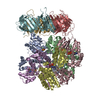
|
|---|---|
| 1 |
|
- 要素
要素
-Replication factor C subunit ... , 5種, 5分子 ABCDE
| #1: タンパク質 | 分子量: 66221.227 Da / 分子数: 1 / 断片: UNP residues 556-1148 / 由来タイプ: 組換発現 / 由来: (組換発現)  Homo sapiens (ヒト) / 遺伝子: RFC1, RFC140 / 発現宿主: Homo sapiens (ヒト) / 遺伝子: RFC1, RFC140 / 発現宿主:  |
|---|---|
| #2: タンパク質 | 分子量: 39203.207 Da / 分子数: 1 / 由来タイプ: 組換発現 / 由来: (組換発現)  Homo sapiens (ヒト) / 遺伝子: RFC2 / 発現宿主: Homo sapiens (ヒト) / 遺伝子: RFC2 / 発現宿主:  |
| #3: タンパク質 | 分子量: 38545.512 Da / 分子数: 1 / 由来タイプ: 組換発現 / 由来: (組換発現)  Homo sapiens (ヒト) / 遺伝子: RFC5 / 発現宿主: Homo sapiens (ヒト) / 遺伝子: RFC5 / 発現宿主:  |
| #4: タンパク質 | 分子量: 39751.668 Da / 分子数: 1 / 由来タイプ: 組換発現 / 由来: (組換発現)  Homo sapiens (ヒト) / 遺伝子: RFC4 / 発現宿主: Homo sapiens (ヒト) / 遺伝子: RFC4 / 発現宿主:  |
| #5: タンパク質 | 分子量: 40614.332 Da / 分子数: 1 / 由来タイプ: 組換発現 / 由来: (組換発現)  Homo sapiens (ヒト) / 遺伝子: RFC3 / 発現宿主: Homo sapiens (ヒト) / 遺伝子: RFC3 / 発現宿主:  |
-タンパク質 , 1種, 3分子 FGH
| #6: タンパク質 | 分子量: 28795.752 Da / 分子数: 3 / 由来タイプ: 組換発現 / 由来: (組換発現)  Homo sapiens (ヒト) / 遺伝子: PCNA / 発現宿主: Homo sapiens (ヒト) / 遺伝子: PCNA / 発現宿主:  |
|---|
-非ポリマー , 3種, 9分子 




| #7: 化合物 | ChemComp-MG / #8: 化合物 | ChemComp-AGS / #9: 化合物 | ChemComp-ADP / | |
|---|
-詳細
| 研究の焦点であるリガンドがあるか | Y |
|---|
-実験情報
-実験
| 実験 | 手法: 電子顕微鏡法 |
|---|---|
| EM実験 | 試料の集合状態: PARTICLE / 3次元再構成法: 単粒子再構成法 |
- 試料調製
試料調製
| 構成要素 | 名称: Human Replication factor C (RFC) complex bound to the sliding clamp Proliferating cell nuclear antigen (PCNA) タイプ: COMPLEX 詳細: hRFC construct with a truncation of the A subunit's N-terminal region (missing residues 1-555) Entity ID: #1-#6 / 由来: RECOMBINANT |
|---|---|
| 分子量 | 値: 0.31 MDa / 実験値: NO |
| 由来(天然) | 生物種:  Homo sapiens (ヒト) Homo sapiens (ヒト) |
| 由来(組換発現) | 生物種:  |
| 緩衝液 | pH: 7.5 |
| 試料 | 包埋: NO / シャドウイング: NO / 染色: NO / 凍結: YES |
| 試料支持 | グリッドの材料: GOLD / グリッドのタイプ: Quantifoil R0.6/1 |
| 急速凍結 | 凍結剤: ETHANE / 湿度: 95 % / 凍結前の試料温度: 283.15 K |
- 電子顕微鏡撮影
電子顕微鏡撮影
| 実験機器 |  モデル: Titan Krios / 画像提供: FEI Company | |||||||||||||||||||||
|---|---|---|---|---|---|---|---|---|---|---|---|---|---|---|---|---|---|---|---|---|---|---|
| EM imaging | 加速電圧: 300 kV / 電子線源:
| |||||||||||||||||||||
| 撮影 |
|
- 解析
解析
| ソフトウェア |
| ||||||||||||||||||||||||||||||||||||
|---|---|---|---|---|---|---|---|---|---|---|---|---|---|---|---|---|---|---|---|---|---|---|---|---|---|---|---|---|---|---|---|---|---|---|---|---|---|
| EMソフトウェア |
| ||||||||||||||||||||||||||||||||||||
| CTF補正 | タイプ: PHASE FLIPPING AND AMPLITUDE CORRECTION | ||||||||||||||||||||||||||||||||||||
| 対称性 | 点対称性: C1 (非対称) | ||||||||||||||||||||||||||||||||||||
| 3次元再構成 | 解像度: 3.4 Å / 解像度の算出法: FSC 0.143 CUT-OFF / 粒子像の数: 193934 詳細: Multi-body refinement was used to generate 2 reconstructions that were combined 対称性のタイプ: POINT | ||||||||||||||||||||||||||||||||||||
| 原子モデル構築 | プロトコル: OTHER / 空間: REAL 詳細: Initial local fitting was peformed using UCSF Chimera, followed by manual model adjustment, then refinement in PHENIX. | ||||||||||||||||||||||||||||||||||||
| 精密化 | 交差検証法: NONE 立体化学のターゲット値: GeoStd + Monomer Library + CDL v1.2 | ||||||||||||||||||||||||||||||||||||
| 原子変位パラメータ | Biso mean: 63.28 Å2 | ||||||||||||||||||||||||||||||||||||
| 拘束条件 |
|
 ムービー
ムービー コントローラー
コントローラー



 UCSF Chimera
UCSF Chimera
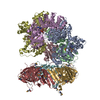
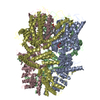


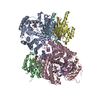

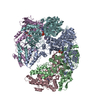
 PDBj
PDBj






















